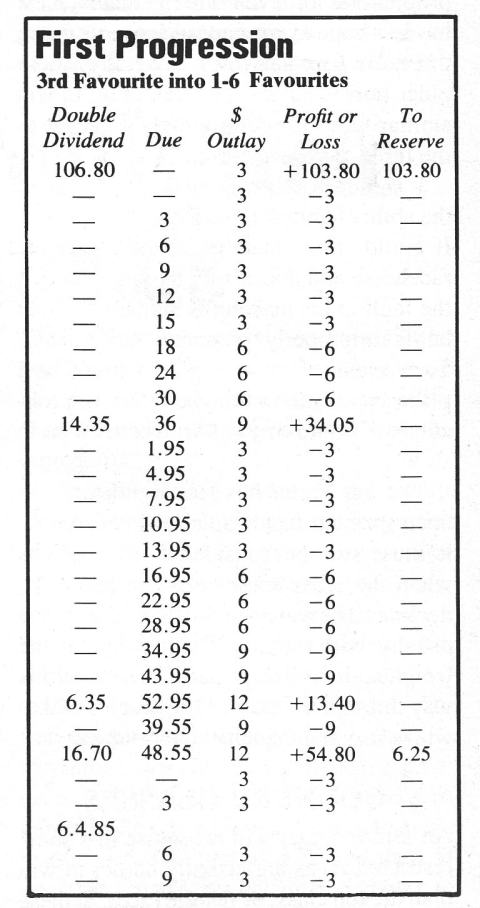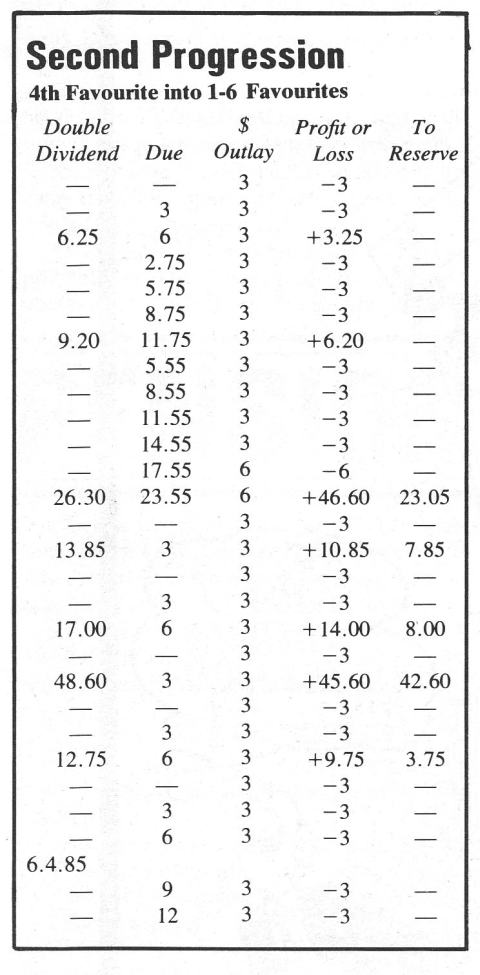For the businesslike punter, the extra and daily doubles can be a source of worthwhile profits. Most who bet on the doubles use a combination of horses. For example, they may have three horses in the first leg and another three in the second leg. Such a combination gives nine double combinations at a cost (for 500) of $4.50.
By combining several horses in this fashion you should hit the double fairly often, but you will also lose a lot of them, and with a nine unit outlay each time you're almost certain to end up a loser.
Sudden wealth is the lure the double holds out to the optimistic punter. There may he a rainbow but usually no pot of gold. However, as most enjoy playing the double let's look at a proper money management approach that should make your double betting more reliable - and profitable.
The method I am going to outline for you right now hits doubles frequently and every now and then a surprisingly good one, as the workout of results show. I am using pre-post markets as the basis of the workout for simplicity's sake. However, I am not necessarily advocating the use of pre-post markets, for you can use any method of daily double selection you want. The selection method is not essential in this article, as it is the money management approach that makes it pay.
We are going to play two progressions at the same time. The first race of the double in each progression will be our key race. In the first progression (see figure one), the third favourite in pre-post markets is our key horse in the first leg.
In the second progression (see figure two) our key horse is the fourth favourite in pre-post markets. I have used the third and fourth pre-post favourites as key horses because they generally give a balance between shorter and longer priced horses. As already mentioned, the aim of this article is money management - not necessarily a selection method. However, you will find the key horse method outlined can be used on as many as the first six pre-post favourites.
We have covered the key horse in the first leg of each progression. In the second leg of each progression, we include the first six pre-post favourites, so our opening doubles bet in each progression reads as follows:
First Progression
| 1st leg | 3rd pre-post favourite |
| 2nd leg | 1st; 2nd; 3rd; 4th; 5th; 6th |
| | pre-post favourites |
| Outlay (50c unit) | 1 x 6 = $3.00 |
Second Progression | 1st leg | 4th pre-post favourite |
| 2nd leg | 1st; 2nd; 3rd; 4th; 5th; 6th |
| | pre-post favourites |
| Outlay (50c unit) | 1 x 6 = $3.00 |
We will play each of these progression series independently, with the progress of one never influencing the progress of the other.
In each progression we will set up a due column and every bet lost will be entered in this column. We will always divide our due column by fifteen (15) and this will tell us how many double tickets to buy in each progression.

For example, if the due is $60.00, fifteen will divide into it four times. Therefore, we are required to buy four doubles on each combination. In this particular progression, for a cost of $12.00 (1 x 6 X 4 = 24 X 500 = $12.00).
Whenever we hit a double paying a little better than $15.00 (for 500) we will clear our due column. Any double around $20.00 gives a fair profit.

Remember, we are playing two progressions and playing each one separately. We have six combinations to play in each progression for a start cost of three dollars. This is figuring one ticket on each combination. When we lose we put the total amount lost in the due columns and divide by fifteen. The resulting figure is not the amount we bet, but the amount of tickets we have to buy on each combination. Any fractions should be rounded up to the nearest whole number (i.e. $48 in the due column divided by 15 = 3.2. Therefore, round up to 4).
When we hit a winning double, we deduct the full amount bet in that progression, then deduct the profit from the due column. Anything left after deducting from the due is the profit for that particular progress and is placed in reserve.
Study the workouts carefully, and I'm sure all of this will he very clear.
All scratchings are eliminated from prepost markets on race day mornings. Playing this method on Sydney Saturday extra and daily doubles from 1 st January 1985, we covered 28 double races. We hit 11 doubles in this period, a strike rate of 39%. The biggest bet we were ever required to make was $12.00.
In both progression series there was a flat bet profit totalling 49.5%. However, by utilising the money management method this improved to 71.9% - on increased turnover.
FIRST PROGRESSION SUMMARYOutlay = $90
Profit = $70.25 = 78.1%
SECOND PROGRESSION SUMMARYOutlay = $144
Profit = $98.05 = 68.1%
By Statsman
PRACTICAL PUNTING - JUNE 1985